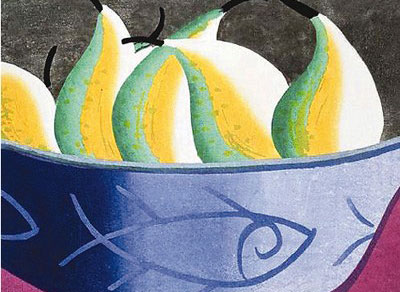(Ecns.cn)--Printmaking has developed in China for more than 1,000 years, although prior to the 1930s, the most recognized form was the woodcut. Not long after, new forms were introduced from the West.
In 1931, Lu Xun, one of the major Chinese writers of the 20th century, initiated a reform movement in printmaking by introducing advanced foreign techniques to China.
Chinese artists then began creating prints with an element of originality, rather than just copying.
Recently, in a bid to honor the development of printmaking in the country, the Chinese Artists Association named 2011 as China's printmaking year.
Major periods of development
There are mainly three periods of development for contemporary printmaking in China, starting from 1931. The first was during the New Democracy period, the second was after the birth of New China and the third came after the development of the market economy.
Due to the restrictive conditions in the 1930s, the priority was given to the woodcut, a means of printing patterns mainly on cloth. But during the New Democracy period, a small group of artists were moved to learn new printmaking techniques.
After the founding of New China in 1949, the situation underwent explosive change. Oil painting, traditional Chinese painting, water-color and gouache painting all began developing rapidly.
Not only was printmaking established in the academies as a specialist area of study, but woodcut printing workshops, lithography and intaglio workshops were also set up.
The fundamental techniques of making prints were Western in form, including planographic printing, intaglio printing, relief printing and stencil printing.
In the period from 1979-1980, elderly printmaker Li Hua, a teacher at the Chinese Central Academy of Fine Arts Printmaking Department, invited his fellow townsman Zheng Ke, from the Chinese Central Arts and Crafts Institute, to teach the research class.
As printmaking techniques were learned by more and more people, the art ushered in a golden period of development from 1977 to 1989, with many works reflecting the lives of ordinary people and the changes in society.
Current hardships
Since the mid 1990s, China has shifted its economic pattern to a market economy, which has had an adverse affect on printmaking, causing the number of people dedicated to the art to shrink.
Compared with oil painting and traditional Chinese painting, printmaking is much less profitable in China, as many people think that printmaking involves the copying of paintings.
"Actually, printmaking is different from printing, which is a process capable of producing multiples of the same piece. Yet people may not know that in printmaking, the artist also brings his or her own creativity to the work," said Su Xinping, a senior professor at China's Central Academy of Fine Art.
Currently in China, many artists focus too much on printmaking technique, which has led them to ignore the creation of original art.
Chinese artists should find ways to create awareness about the form and, instead of copying traditional Chinese paintings, they should develop new ideas and keep up with the times, said Su.
Inviting the public to the see the printmaking process, using modern media for promotion and providing more exposure for trial works are things artists should do, added Su.
In recent years, many exhibitions held in China and in foreign countries have helped to promote the art, but more needs to be done. Chinese artists should learn from the West and communicate more with others, said another expert.




















